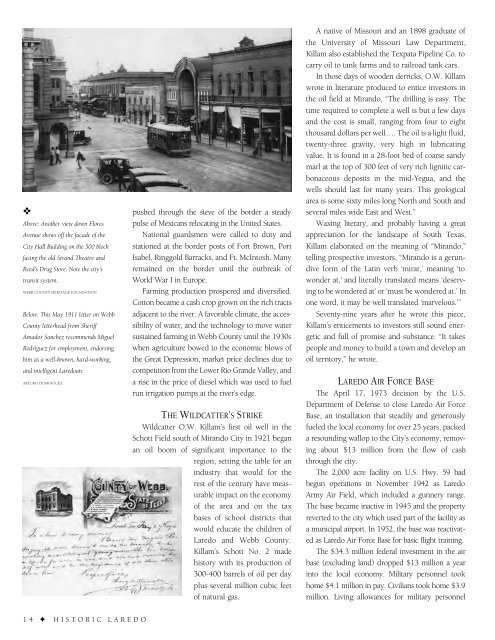Historic Laredo
An illustrated history of the city of Laredo and the Webb County area, paired with the histories of companies, families and organizations that make the region great.
An illustrated history of the city of Laredo and the Webb County area, paired with the histories of companies, families and organizations that make the region great.
You also want an ePaper? Increase the reach of your titles
YUMPU automatically turns print PDFs into web optimized ePapers that Google loves.
❖<br />
Above: Another view down Flores<br />
Avenue shows off the facade of the<br />
City Hall Building on the 500 block<br />
facing the old Strand Theatre and<br />
Reed’s Drug Store. Note the city’s<br />
transit system.<br />
WEBB COUNTY HERITAGE FOUNDATION<br />
Below: This May 1911 letter on Webb<br />
County letterhead from Sheriff<br />
Amador Sanchez recommends Miguel<br />
Rodriguez for employment, endorsing<br />
him as a well-known, hard-working,<br />
and intelligent <strong>Laredo</strong>an.<br />
ARTURO DOMINGUEZ<br />
pushed through the sieve of the border a steady<br />
pulse of Mexicans relocating in the United States.<br />
National guardsmen were called to duty and<br />
stationed at the border posts of Fort Brown, Port<br />
Isabel, Ringgold Barracks, and Ft. McIntosh. Many<br />
remained on the border until the outbreak of<br />
World War I in Europe.<br />
Farming production prospered and diversified.<br />
Cotton became a cash crop grown on the rich tracts<br />
adjacent to the river. A favorable climate, the accessibility<br />
of water, and the technology to move water<br />
sustained farming in Webb County until the 1930s<br />
when agriculture bowed to the economic blows of<br />
the Great Depression, market price declines due to<br />
competition from the Lower Río Grande Valley, and<br />
a rise in the price of diesel which was used to fuel<br />
run irrigation pumps at the river’s edge.<br />
THE WILDCATTER’S STRIKE<br />
Wildcatter O.W. Killam’s first oil well in the<br />
Schott Field south of Mirando City in 1921 began<br />
an oil boom of significant importance to the<br />
region, setting the table for an<br />
industry that would for the<br />
rest of the century have measurable<br />
impact on the economy<br />
of the area and on the tax<br />
bases of school districts that<br />
would educate the children of<br />
<strong>Laredo</strong> and Webb County.<br />
Killam’s Schott No. 2 made<br />
history with its production of<br />
300-400 barrels of oil per day<br />
plus several million cubic feet<br />
of natural gas.<br />
A native of Missouri and an 1898 graduate of<br />
the University of Missouri Law Department,<br />
Killam also established the Texpata Pipeline Co. to<br />
carry oil to tank farms and to railroad tank cars.<br />
In those days of wooden derricks, O.W. Killam<br />
wrote in literature produced to entice investors in<br />
the oil field at Mirando, “The drilling is easy. The<br />
time required to complete a well is but a few days<br />
and the cost is small, ranging from four to eight<br />
thousand dollars per well…. The oil is a light fluid,<br />
twenty-three gravity, very high in lubricating<br />
value. It is found in a 28-foot bed of coarse sandy<br />
marl at the top of 300 feet of very rich lignitic carbonaceous<br />
deposits in the mid-Yegua, and the<br />
wells should last for many years. This geological<br />
area is some sixty miles long North and South and<br />
several miles wide East and West.”<br />
Waxing literary, and probably having a great<br />
appreciation for the landscape of South Texas,<br />
Killam elaborated on the meaning of “Mirando,”<br />
telling prospective investors, “Mirando is a gerundive<br />
form of the Latin verb ‘mirar,’ meaning ‘to<br />
wonder at,’ and literally translated means ‘deserving<br />
to be wondered at’ or ‘must be wondered at.’ In<br />
one word, it may be well translated ‘marvelous.’”<br />
Seventy-nine years after he wrote this piece,<br />
Killam’s enticements to investors still sound energetic<br />
and full of promise and substance. “It takes<br />
people and money to build a town and develop an<br />
oil territory,” he wrote.<br />
LAREDO AIR FORCE BASE<br />
The April 17, 1973 decision by the U.S.<br />
Department of Defense to close <strong>Laredo</strong> Air Force<br />
Base, an installation that steadily and generously<br />
fueled the local economy for over 25 years, packed<br />
a resounding wallop to the City’s economy, removing<br />
about $13 million from the flow of cash<br />
through the city.<br />
The 2,000 acre facility on U.S. Hwy. 59 had<br />
begun operations in November 1942 as <strong>Laredo</strong><br />
Army Air Field, which included a gunnery range.<br />
The base became inactive in 1945 and the property<br />
reverted to the city which used part of the facility as<br />
a municipal airport. In 1952, the base was reactivated<br />
as <strong>Laredo</strong> Air Force Base for basic flight training.<br />
The $34.3 million federal investment in the air<br />
base (excluding land) dropped $13 million a year<br />
into the local economy. Military personnel took<br />
home $4.1 million in pay. Civilians took home $3.9<br />
million. Living allowances for military personnel<br />
14 ✦ HISTORIC LAREDO
















